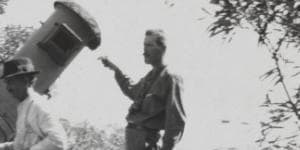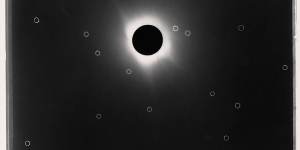
Wallal Downs Station,a remote station 300 kilometres south of Broome on Eighty Mile Beach,was deemed the most ideal place on Earth to view a total eclipse of the Sun.Museum of Western Australia
The general feeling amongst the scientists is that the observations were quite successful.
Further photographs of the sky will be taken to-night,and then the instrument will be taken down and returned to Perth,India,England,the United States,and Canada.
PERTH,Thursday.
Perfect weather favoured the astronomers to-day at Wallal.
After the partial phase had commenced,the scientists gathered round their respective instruments and waited for totality. Long before this the whole appearance of the landscape had changed. The sky became a deeper blue,except near the horizon,where a peculiar yellow tinge was noticeable. The western sky was distinctly darker than the eastern,and this difference became more marked as totality drew nearer.
The change in the character of the light during the last two minutes before the total phase was remarkable. The landscape assumed in turn a yellowish then a greenish blue,then a purple colour,and the shadows cast by the narrow crescent of the sun were sharp and harsh. Just as the moon covered the sun the phenomenon of Bally’o Beads was noticed.
The crescent broke up into a series of brilliant detached points like the gems of a necklace. At the same time the corona burst into view. Its colour was not pure white,but tended rather to a creamy tinge. The great brilliance of the inner portion of the corona to some extent detracted from the brightness of the streamers,but nevertheless the corona was a wonderful sight.
With the advent of totality the eclipse programmes were started and carried through with clockwork precision. All the parties expressed themselves as thoroughly satisfied with their observations. As these were chiefly photographic,it is as yet too soon to speak of the scientific value of the records obtained,but there is every reason to believe that Wallal will be associated always with important advances made in astronomical science.

An Einstein plate showing the eclipse totality. The circles denote the positions of stars around the edge of the Sun.UNIVERSITY LIBRARY,UC SANTA CRUZ
The main visual observations made to-day were in connection with the shadow bands.
The dusky streaks seemed to be flitting across the ground just before and after totality.
The bands were very indistinct,and travelled faster than usual,the speed being about six miles per hour. Observations made bear out the theory that these bands are due to inequality in our atmosphere rather than to anything connected with sun and moon. The eclipse was possibly slightly darker than the average,but lamps were never needed in the open.
Interviewed after the eclipse,Dr. Campbell,of the Lick Observatory,leader of the expedition,stated that the conditions of the sky and air were perfect. He was highly satisfied with the performance of his instrument and the work of his observers. He said that he intended to develop a few plates at Wallal as a test,but the main photographic work would be deferred until the party arrived at Broome,where ice could be obtained to cool the chemicals used,and where the dust problem would not be so serious.
Professor Chant,of the Canadian party,also expressed himself as thoroughly satisfied with the work accomplished. The work of developing is being postponed until arrival in Broome,as in the case of the Lick party.
Mr. Evershed,of India,said that be desired to express his indebtedness to the Australian Government and Commander Quick for the facilities he had obtained for his work,and to Mr. D. W. Everson,of the University of Western Australia,for his aid in setting up and using instruments.
Mr. Hargrave,of the English party,was also well satisfied with the eclipse work,although owing to a slight this chance the self-recording magnetic apparatus had failed to register.
The Western Australian party have obtained a number of photographs of the corona,and at their camp at Wallal Downs Station had the same fine observing conditions. As at the main camp,the natives were rather afraid of the eclipse,and kept out of sight until daylight returned to normal. They have amassed some astronomical knowledge of eclipses during the past few weeks,but do not feel too certain about it. The 40ft camera is always regarded with a certain awe,and is passed at a safe distance. After the eclipse was over the natives appeared satisfied with the efforts of the astronomers to clear up the sun again.